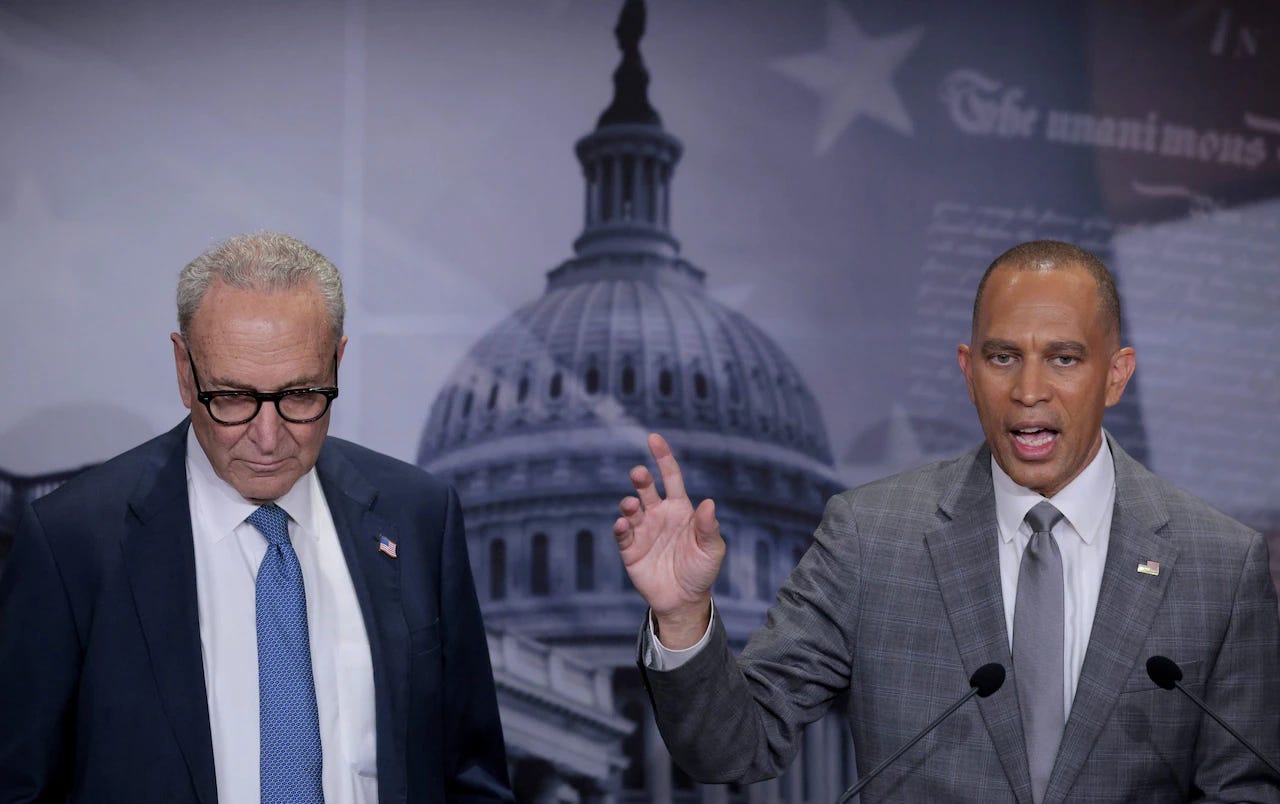Trump Has Set the Democrats Up for a Shutdown Humiliation
The President has trapped his political opponents. They can either surrender to the White House or accept punishing, likely irreversible cuts to the Deep State bureaucracy.
This analysis is free, but with Premium Membership you get MORE. Join today.
by Charles Lipson
September 30, 2025
The most pressing political question in Washington right now is whether the government will shut down at 12:01 AM on October 1.
If it does, all “non-essential operations” will pause. Essential ones, like the armed forces, border enforcement, and Social Security payments, will continue. But the Department of Silly Walks will stop until a funding bill is passed.
How could a multi-trillion dollar government simply stop so many of its activities? Because the U.S. Constitution divides budgetary authority between the legislative and executive branches, and that authority runs out on October 1. Senate Democrats are refusing to authorise the continuation of non-essential spending, including a temporary extension of the current budget, until they get some items on their wish list. Those items would add another trillion dollars to the deficit, and Republicans have refused.
Republicans don’t just think more spending on social programs is a bad idea. They think a shutdown gives them a unique opportunity to permanently end some of those programs and fire the bureaucrats who administer them.
Even so, the White House and Congressional Republicans have still given Democrats a chance to climb down. Indeed, they have proposed a simple solution to the current impasse, one that has been used many times and, until now, has always had bipartisan support. They would pass a straightforward “continuing resolution” (a “clean CR”) that renews previous levels of spending (on existing programmes) for another month or two. During that time, Republicans would try to pass a series of spending authorizations for different government functions, a process ironically called “regular order”, but which has not actually been used for two decades.
If Congressional Democrats were willing to pass a straightforward CR, there would be no shutdown. They aren’t. They are demanding to sweeten the pill with some very expensive side deals — including lavishly funding Medicaid for illegal aliens — and have spent weeks making those sweeteners a national issue, mostly to appeal to their increasingly Leftwing base.
Republicans won’t accept any of that. It’s hard to understand how savvy Democrat leaders would think that they would.
Those Democrat demands and the Republicans’ refusal have resulted in a stalemate. Republicans managed to pass a “clean CR” in the House, where they have a slender majority. But they cannot pass it in the Senate without some Democrat votes, since the Republicans are seven votes short of the 60-vote supermajority they need. The Senate’s leading Democrat, Chuck Schumer of New York, is determined to hold his caucus together and block the “clean CR”.
In the past, Republicans would have folded, knowing that they would be held responsible for any shutdown, regardless of where fault actually belonged. This time is different, for a couple of reasons.
First, the mainstream media, which blames Republicans for the sun rising in the East, has lost most of its audience and most of its power. The biggest change is not the rise of cable TV or the dominance of Fox News — it is the fragmentation of audiences thanks to the internet. More and more voters get their news from social media, where they are able to find — or be algorthmically bombarded with — information they simply could not get in an earlier era. The days of one-sided cheerleading for the Democrats is over.
Second, Donald Trump and his allies believe that they can use the shutdown to accomplish some major goals and that they have trapped the Democrats into giving them the chance.
Those goals are to permanently cut the federal workforce and end a series of progressive programs. Normally, a shutdown would see government workers “furloughed” temporarily and put back on the job after the continuing resolution passes. They are then given back pay for all their days on furlough. All the old programs resume, unchanged if not expanded.
Trump has no intention of doing that. If there is a shutdown, he has authority to determine which functions are and are not essential, and unlike his Republican predecessors, he will immediately begin implementing a permanent “reduction in force” of the federal bureaucracy. And the Democrats are stumbling toward giving him that opportunity. They are refusing to vote for any CR, at least for now, unless Trump agrees to load the bill with more spending.
He won’t.
Trump’s program has been mapped out by his key budget aide, Russ Vought (pronounced “vote”), who heads the Office of Management and Budget and who succeeded Elon Musk as the head of DOGE. Cabinet officials have been working with him to identify programs and personnel to cut. To quote an old line from (Democrat) Rahm Emanuel: “You never want a serious crisis to go to waste. And what I mean by that is an opportunity to do things you think you could not do before.”
That is exactly what Trump, Vought, and their administration intend to do.
The prospect of these cuts is chilling to Democrats, who are, at bottom, the “party of government”. The epicentre of that “party of government” are the two Democrat senators from Virginia, a “purple” state filled with government workers. It’s hard to imagine those two senators sticking with a party line that could cost them the next election.
The question is whether these vulnerable Democrats can convince Chuck Schumer that he is pursuing a foolhardy strategy that might appeal to the party’s anti-Trump, far-Left activist base, but risks losing support from moderate voters concerned about bloated, ineffective programs and a ballooning federal deficit.
The dilemma facing Schumer and his Senate caucus is how to extricate themselves from the mess they have made for themselves. That boils down to a simple question: When will they concede to Trump’s demand for a simple continuing resolution, without any add-ons, and swallow the humiliation they brought on themselves by fulminating against it for weeks?
Their second dilemma may be harder: what happens to them politically if they give in?
— Charles Lipson is the Peter B. Ritzma professor of political science emeritus at the University of Chicago. His latest book is Free Speech 101: A Practical Guide for Students. This article originally appeared at The Telegraph.









